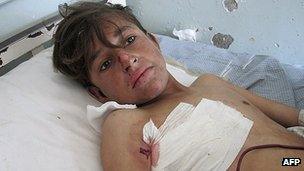Civilian casualties in Afghanistan fall
- Published

The number of civilian casualties in Afghanistan has fallen for the first time in six years, a UN report says.
The UN Assistance Mission in Afghanistan (Unama) documented 2,754 civilian deaths in 2012, a 12% drop, and 4,805 injuries, a slight rise.
The reduction was attributed to less fighting on the ground, and a decline in suicide attacks and air operations.
But the report also expressed concern about the re-emergence of armed groups, particularly in Afghanistan's north.
Civilians also faced an increase in threats, intimidation and interference with their rights to education, health, justice and freedom of movement from militants, it added.
'Redoubled efforts'
Jan Kubis, the UN special representative in Afghanistan, said the decrease in civilian casualties in 2012 was "very much welcome" but that the "human cost of the conflict remains unacceptable".
"Indiscriminate and unlawful use of improvised explosive devices by anti-government elements remains the single biggest killer of civilians.
"Steep increases in the deliberate targeting of civilians perceived to be supporting the government demonstrates another grave violation of international humanitarian law."
Particularly appalling, Mr Kubis added, was the use of suicide attacks - including those carried out by "brainwashed" children - to murder civilians.
In total, 81% of civilian casualties in 2012 were attributed to militants, while 8% resulted from operations by pro-government forces.
It also noted that women and girls "continued to suffer enormously from the effects of armed conflict", with 301 killed and 563 injured - an increase of 20%.
"It is the tragic reality that most Afghan women and girls were killed or injured while engaging in their everyday activities," said Georgette Gagnon, Unama's director of human rights.
The report said improvised explosive devices (IEDs) planted by insurgents were the greatest threat to civilians, causing 868 deaths and 1,663 injuries. Targeted killings by militants also increased by 108%, with 698 people killed and 379 hurt.
"Unama notes numerous Taliban statements in 2012 to protect civilians. Yet, the situation on the ground has not improved. The Taliban increased their direct attacks on civilians through targeted killings and continued to indiscriminately use IEDs," the agency said.
The report said 316 civilians were killed and 271 hurt by pro-government forces, a 46% decrease from 2011. Casualties from aerial operations by international military forces in Afghanistan also decreased by 42%, with 126 deaths and 78 injuries documented.
The BBC's Karen Allen in Kabul says that will come as welcome news for foreign forces, which have faced government pressure in the past week to limit air strikes during anti-Taliban operations civilians areas.
"While fewer Afghan civilians were killed in the armed conflict in 2012, conflict-related violence continued to seriously threaten the lives and well-being of thousands of Afghan children, women and men," said Ms Gagnon. "This situation demands even greater commitment and redoubled efforts to protect Afghan civilians in 2013 and beyond."
Over the past six years, 14,728 Afghan civilians have lost their lives.